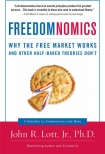Freedomnomics: Why the Free Market Works and Other Half-Baked Theories Don't John Jr. (the dot read aloud .txt) 📖

- Author: John Jr.
Book online «Freedomnomics: Why the Free Market Works and Other Half-Baked Theories Don't John Jr. (the dot read aloud .txt) 📖». Author John Jr.
Was the paver engaging in price discrimination? It might seem so, since I was charged a lower price than our neighbors for the same service. But what goes unseen here is the likely difference in cost for the paver to add my driveway to his list. It was well over ninety degrees, and the owner wanted to let his employees go home early before they were overcome by the heat. Since he didn’t have time to take all his equipment to another job in a different neighborhood, he offered to pave my driveway at a lower price so he could have one more job before sending everyone home. It would not cost him much to add one more job in the same neighborhood, and without it he would be stuck with the extra asphalt.
Here’s another example of pricing that seems discriminatory but is not. My family and friends who frequent restaurants with me have to endure my annoying habit of asking restaurant owners and managers why they do things the way they do. A restaurant near my house charged a couple dollars more for a special takeout Thanksgiving meal for two than they did for two single portions of the same meal. Is this price discrimination targeting customers so blinded by love that they can’t see they will save money by buying two single portions? Hardly. The owner explained that the meal for two includes more than twice as much food as the single portion. The meal is usually ordered by a couple, and the man typically eats more food. It wouldn’t make sense to increase the size of single portions because the price would have to be raised, and customers won’t want to pay more for extra food they don’t need.
It may seem that price discrimination is also at work in the sale of colas. It’s an interesting anomaly that colas tend to be priced at or below the cost of seltzers. For instance, on Amazon.com, six-packs of Seagram’s Seltzer Water in 12 fl. oz cans recently cost $3.85. The drink is produced by Coca-Cola,17 which sold its Diet Coke in the same size six-pack for just $1.99.18 Why on earth would Diet Coke, with its added flavoring and sugar substitute, sell for less than seltzer, which is merely carbonated water? Was this just an anomaly?19
Could this be price discrimination? Are seltzer drinkers being charged higher prices in the belief that they tend to have higher incomes than cola drinkers? This is unlikely; if big profits can be made on purely carbonated water, we should expect other firms to have entered the market, eventually driving down the price. The real, although not readily apparent, explanation is that water quality and carbonization levels have to be higher when pure seltzer is not masked by cola flavoring.20
Now that we’ve established that high prices aren’t always attributable to omnipresent, sinister monopolies or to unfair price discrimination, let’s take a look at some expensive items that are the subject of particularly frequent consumer complaints. Are these cases of price discrimination, monopoly power, and corporate greed? Or, can market forces explain these pricing schemes?
Why Are Dinners and Liquor So Expensive in Restaurants?
Are you curious why restaurants charge substantially higher prices for dinner than for lunch? While the size of the dinners are often slightly larger, meal size alone cannot explain the price difference. The knee-jerk answer is that restaurants charge more for dinner simply because they can. In a sense, this is true; restaurants, like any business, will charge the highest price the market allows in order to maximize profits. But if this holds true for dinner, why not for lunch?
This may seem like another case of price discrimination—supposedly, dinner customers are charged more because lunchtime diners typically work near the restaurants they frequent and are more familiar with the local eateries than are dinner customers, who more often travel to other neighborhoods to dine. Thus lunchtime customers could more easily switch to another establishment if a restaurant raised its lunch prices. But this explanation doesn’t work, for dinners are more expensive than lunches even in cities such as New York City and Washington, D.C. where dozens of restaurants are crammed into a few square blocks, with prices posted at the front door.21 It is easy to compare prices in these neighborhoods, and finding the cheaper dinners is not a problem.
So if price discrimination is not at work, and monopolies clearly are not functioning in areas with so many restaurants, how do we explain the price difference? There is a simple answer totally consistent with competitive markets: dinner patrons linger over their meals longer than lunchtime customers, who usually face more severe time constraints.22 In addition to the cost of the food, the price of a meal has to cover the rental cost of the table. The more leisurely the pace at which people enjoy a meal, the more money a restaurant loses by not selling meals to additional customers at that table. Anyone who regularly frequents restaurants has surely come across waiters who subtly rush patrons with little maneuvers like clearing the table before all the diners have even finished eating. In the restaurant business, time is money.
This time cost of the table also explains why certain kinds of drinks are so much more expensive in restaurants than in stores. Restaurants charge particularly high prices for coffee, tea, and wine because people either linger over these items or linger longer over meals that include them. The mark-up is highest for beverages that people linger over longest. That’s why wine typically has a larger absolute mark-up than beer, and why both have larger mark-ups than soda.23
Alcohol and coffee also have other costs. Restaurants typically stock all types of liquor, incurring real inventory costs. They also have to throw out many cups of coffee over the day to insure freshness. All these





Comments (0)